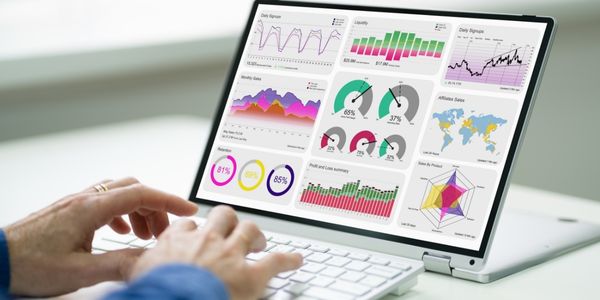Organizations collecting data and using it to inform key decisions isn’t a revolutionary new idea. Humanity has made a lot of progress on the back of this time-tested approach. But with modern technology, huge troves of data can be collected and analyzed efficiently—and that opens up additional opportunities for skilled tech workers like data analysts.

But what does a data analyst do, exactly? In this article, we’ll take an in-depth look at what you’ll find in a data analyst’s job description and highlight some of the lesser-known aspects of the job.
What is a data analyst?
Simply put, data analysts work with large datasets to help identify trends, issues or other key information for an organization’s success. This may include tasks like analyzing data systems, automating information retrieval and preparing reports that show managers or other key decision makers how this data could be applied.
It should be noted that while this article focuses on the specific “data analyst” job title, there are several closely related roles that can fit under this category of workers. Other common titles include business intelligence analyst, market intelligence analyst and process analyst. While there are differences to be found between these roles, the core skills and duties overlap significantly.
What are common data analyst duties?
According to the U.S. Department of Labor, common duties for business intelligence analysts (a type of data analyst) include:1
- Analyze business processes, systems and other metrics for trends and patterns
- Generate reports summarizing business, financial or economic data
- Communicate findings with relevant employees and key partners
- Create and present operational recommendations for management and stakeholders
- Manage databases and maintain libraries of business documents and templates
- Design and oversee the creation of systems, databases, spreadsheets or other business tools
In many data analyst roles, the root of this work is based on driving efficiencies, identifying opportunities and anticipating needs. For example, a data analyst may be tasked with exploring how a new feature on a retail mobile app influences sales or customer behavior. Or they could be tasked with developing a report on the probable impact of a new product pricing structure. There are countless applications to data analysis techniques—which makes skilled analysts a valuable asset across industries.
What skills do employers look for in data analysts?
To help answer this, we’ve used job posting analysis software to identify some of the most sought-after skills employers are seeking in data analyst candidates. Here’s a sampling of what we found:2
Top technical skills for data analysts
- Statistical analysis
- SQL
- Python®
- Tableau®
- Microsoft Power BI®
- Data management
- Data visualization
- Business intelligence/analysis
- Extraction transformation and loading (ETL)
- SAS®
- Data modeling
While it’s certainly great to have a strong grasp of all the tools and skills listed above, you shouldn’t overlook the soft or transferable skills needed for this role. For instance, data analysts ideally need to be strong communicators who can effectively report their findings—whether that’s in easy-to-digest summaries or in-depth technical reports.
Also important is their ability to think critically and contextualize what the data represents. Are your recommendations feasible? What information may be missing, and what are the shortcomings of this data that may be influencing your analysis? Being able to step back from the statistical work to see the big picture is helpful.
Given the high-level thinking and technical skillset needed for these roles, it shouldn’t come as a surprise that this role typically requires a college education. Our analysis found that over 90 percent of data analyst job postings were seeking candidates with a bachelor’s degree at a minimum.2
Looking beyond the data analyst job description
The work of a data analyst may sound like a good fit for you on paper, but we all know there can be a gap between how a role sounds in a job description and what it actually entails. So what else should you know about data analyst roles? We ask those who work in the field to share some insight into the aspects of the job that may surprise newcomers.
1. You’ll need top-notch communication and writing skills
“Communication skills and strong comprehension of different business languages are actually way more important than you may think,” says Andy Chan, data analyst and founder of Prime Opt.
It’s easy to get caught up in learning programming languages and statistical analysis techniques, but don’t underestimate the role good communication plays in data analyst jobs. Data is only useful if you can share it in a way that’s easy to understand and valuable to different users, such as marketing professionals or administrative managers, explains Chan.
A lot of that sharing is done through writing.
“It is essential for data analysts to understand the languages of different industries,” Chan says. Data analysts often need to act as translators, communicating complex information into a language their colleagues can understand.
2. Data analysis requires collaboration
You may picture data analysts as working in solitude at a computer all day. But the reality is that data analysts collaborate with a wide variety of project stakeholders and internal team members. In a given day, you may be gathering input from other data professionals on how to best approach a problem, working with functional area leads to better understand what data represents or even presenting your findings to leadership. Knowing how to build relationships and a strong rapport with everyone involved can make you a more effective analyst.
3. Be prepared to defend your analyses
Companies use data analysts to discover the most effective, efficient and profitable ways for them to conduct their business. Often the recommendations from an analyst’s report can lead to leadership needing to make some very consequential decisions. Your analyses will undoubtedly receive careful scrutiny and potential pushback if it goes against the grain. That means you’ll need to defend your conclusions and also acknowledge where there may be uncertainty.
“The most valuable data-driven insights are those that do not confirm but rather challenge conventional wisdom,” says Jacob Ayres-Thomson, head of data sciences for Just Group.
4. You’ll be able to stretch your creativity
Working with qualitative data and numbers all day doesn’t sound like it leaves much room for creativity. But in reality, data analysts have plenty of opportunities to stretch their imagination.
“I find the most valuable skill is to find creative, out-of-the-box ways that mining data can unlock the very business model of the firm,” Ayres-Thomson says.
The most helpful data isn’t necessarily what you’d expect it to be, he adds. Successful data analysts use creative thinking to find valuable data where no one else thought to look.
Do you have a future as a data analyst?
Now that you know what’s really behind the data analyst job description, you might be thinking that digging into data sounds like the perfect career for you. Learn how our Data Analytics program can help set the stage for an impactful analyst career.
1U.S. Department of Labor, Occupational Employment Statistics [accessed February 2022]. https://www.onetonline.org/link/summary/15-2051.01 Salary ranges represent national, averaged earnings for the occupations listed and include workers at all levels of education and experience. Ranges do not represent starting salaries and employment conditions in your area may vary.
2Burning-Glass.com (analysis of 88,232 data analyst job postings, Jan. 01, 2021 - Dec. 31, 2021.)
Python is a registered trademark of Python Software Foundation, Inc.
Tableau is a registered trademark of Tableau Software.
Microsoft Power BI is a registered trademark of Microsoft Corporation.
SAS is a registered trademark of SAS Institute, Inc.




